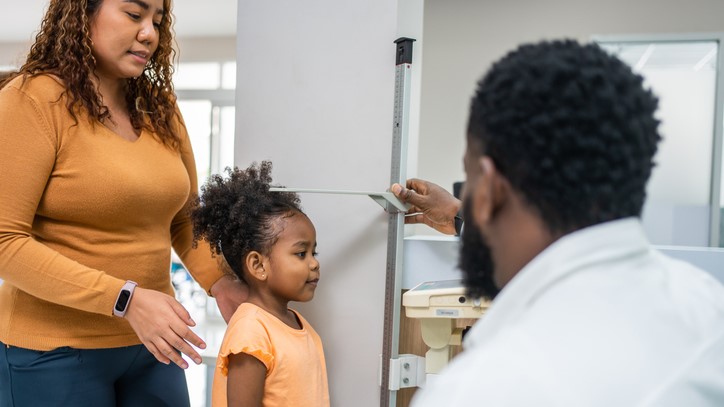-and-
Despite the decline, New Mexico Department of Health (NMDOH) officials say obesity remains a complex and serious public health concern in New Mexico and across the nation.
Source: New Mexico Department of Health
Photo: Courtesy CDC
SANTA FE – Obesity rates have decreased for third graders for the fourth consecutive year, based on the most recent data from 40 schools in 21 counties.
Despite the decline, New Mexico Department of Health (NMDOH) officials say obesity remains a complex and serious public health concern in New Mexico and across the nation. Food insecurity, among other factors, can affect childhood obesity rates.
Key findings from the report, issued by NMDOH’s Obesity, Nutrition and Physical Activity Program (ONAPA):
- Obesity rates for kindergarten students decreased this past year, from 18.2 percent to 17.3 percent.
- Obesity rates for third graders also decreased this past year, from 27.5 percent to 24.1 percent.
- Boys’ obesity rates were 6.5 percent higher than girls.
- American Indian students continue to have the highest obesity prevalence at 27.6 percent of students.
To track childhood obesity rates, ONAPA works with elementary schools, nursing programs and high schools to collect BMI (body mass index) measurements of kindergarteners and third graders across New Mexico every fall. Data remains limited due to voluntary participation. Data from nearly 2,950 students were included in this year’s report.
“We collect and analyze obesity data so we can invest our resources in areas that lack infrastructure for safe physical activity and opportunities to buy affordable healthy food,” said Gina DeBlassie, secretary for NMDOH. “Obesity in children highlights inequities in our community infrastructure and access to resources.”
ONAPA and its Healthy Kids Healthy Communities Program partner with state and local organizations to implement long-term changes to policies, systems, and the local environment to address obesity challenges. Strategies include creating edible school and community gardens, the New Mexico Grown Program, farmers’ markets, walking programs, and safe walking and biking routes.
Read the 2024 New Mexico Childhood Obesity Update here.
Childhood Obesity Facts from the CDC
AT A GLANCE
- Approximately 1 in 5 U.S. children and adolescents have obesity.
- Obesity affects some groups more than others, including adolescents, Hispanic and non-Hispanic Black children, and children in families with lower incomes.
- Health care for obesity is expensive for patients and the health care system.
Many U.S. children have obesity
From 2017 to March 2020, the prevalence of obesity among U.S. children and adolescents was 19.7%1. This means that approximately 14.7 million U.S. youths aged 2–19 years have obesity.
For children, obesity is defined as having a body mass index (BMI) at or above the 95th percentile for age and sex.
Age: The prevalence of obesity increased with age. From 2017 to March 2020, obesity prevalence was 12.7% among U.S. children 2–5 years old, 20.7% among those 6–11, and 22.2% among adolescents 12–19.[1]
Race and Ethnicity: Overall, obesity prevalence was highest in Hispanic children (26.2%) and non-Hispanic Black children (24.8%) followed by non-Hispanic white (16.6%) and non-Hispanic Asian (9.0%) children.[1]
Sex: Among U.S. girls, obesity prevalence was highest among non-Hispanic Black girls (30.8%). Among U.S. boys, obesity prevalence was highest among Hispanic boys (29.3%).[1]
Family Income: Obesity prevalence increased as family income decreased. Obesity prevalence was:
- 25.8% among children with family income 130% or less of FPL.[1]
- 11.5% among U.S. children with family income more than 350% of the Federal Poverty Level (FPL).
- 21.2% among children with family income 130% to 350% of FPL.
Obesity data among young children
CDC works with the US Department of Agriculture to analyze obesity data for U.S. children enrolled in the Special Supplemental Nutrition Program for Women, Infants, and Children (WIC). Learn more about WIC and view recent trends.
Health care for obesity is expensive
Health care for obesity is expensive for patients and the health care system. In 2019 dollars, the estimated annual medical cost of obesity among U.S. children was $1.3 billion. Medical costs for children with obesity were $116 higher per person per year than for children with healthy weight. Medical costs for children with severe obesity were $310 higher per person per year than for children with healthy weight.[2]
Related information
Adult Obesity Facts : Information about obesity among adults in the U.S.
About Child and Teen BMI: What BMI is, how it is used, and how it is interpreted.
Child and Teen BMI Calculator: Calculate BMI, BMI percentile, and BMI category for children and adolescents 2–19.





